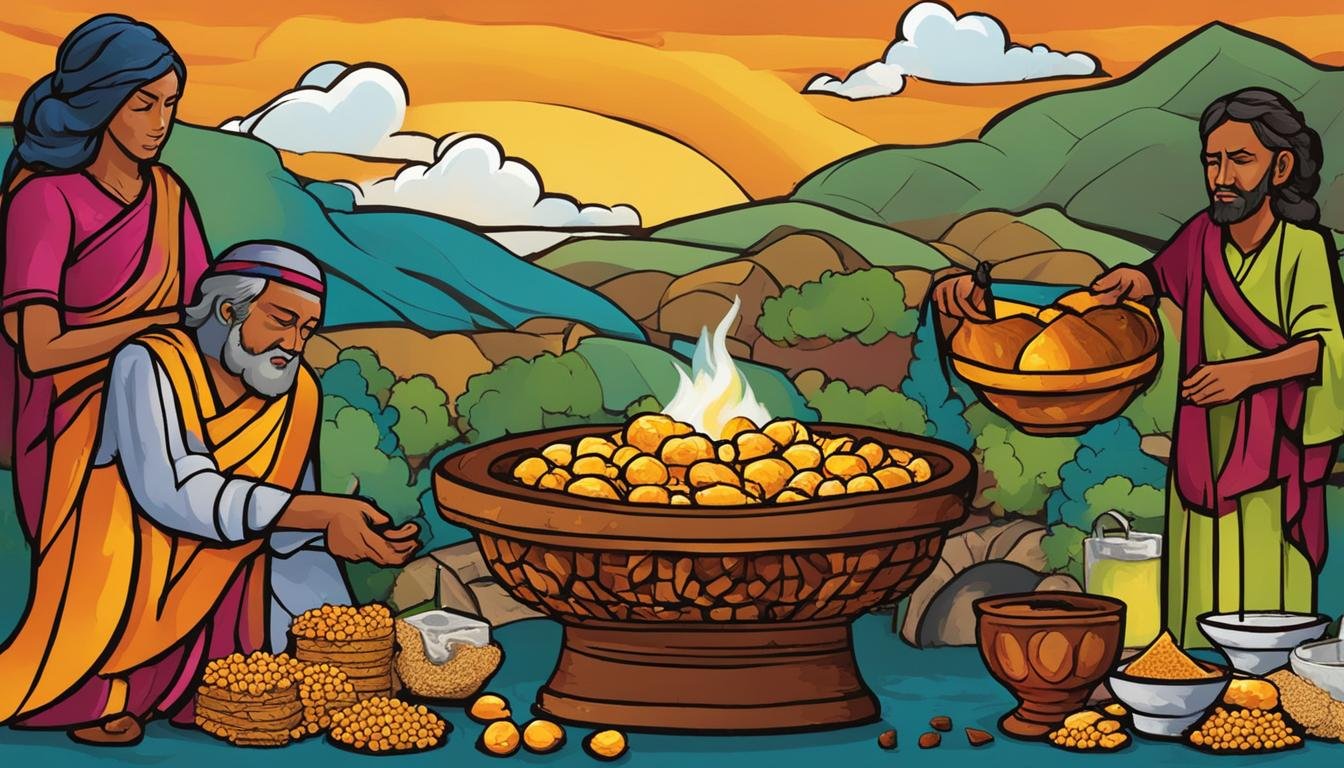In the Bible, there are five main types of offerings or sacrifices: the burnt offering, the grain offering, the peace offering, the sin offering, and the trespass offering. Each of these sacrifices served a specific purpose and function. The burnt, grain, and peace offerings were voluntary, while the sin and trespass offerings were mandatory. The offerings included various elements such as animals, grain, and bread, and were divided into portions. The burnt offering expressed thanks and atoned for unintentional sin, the grain offering expressed gratitude and recognition of God’s favor, the peace offering emphasized fellowship and included a shared meal, the sin offering provided atonement for sins and cleansing from defilement, and the trespass offering was for unintentional sins and included reparation. These sacrifices were practiced in ancient Israel as a means to seek atonement from God.
Key Takeaways:
- The Bible contains five main types of offerings or sacrifices.
- The burnt, grain, and peace offerings were voluntary, while the sin and trespass offerings were mandatory.
- Each offering had a specific purpose and included different elements such as animals, grain, and bread.
- The sacrifices were practiced in ancient Israel as a means to seek atonement from God.
- These offerings expressed thankfulness, gratitude, fellowship, atonement, and reparation.
The Significance of Biblical Sacrifices
The purpose of biblical sacrifices in the Old Testament holds deep meaning and relevance within the context of ancient Israel. These sacrifices played a crucial role in the relationship between God and humanity, providing a means of grace and restoration. Although not intended to earn God’s favor, these offerings served as expressions of devotion, repentance, gratitude, and commitment.
The sacrifices represented a recognition of God’s goodness and provision, as well as a plea for forgiveness and restoration of fellowship. They served as a reminder that sin required atonement and that humankind needed to humble themselves before God. Through these acts of sacrifice, individuals acknowledged their dependence on God’s mercy and sought to reconcile with both God and their fellow human beings.
However, it is essential to note that the sacrifices in the Old Testament were ultimately insufficient in providing complete forgiveness and salvation. They were temporary solutions that pointed to a future fulfillment. It was through Jesus Christ’s ultimate sacrifice on the cross that true redemption and forgiveness of sins were achieved. His offering of Himself as the perfect sacrifice covered and cleansed all sins, offering a way for humanity to find complete atonement and salvation through faith in Him.

The Role of Sacrifices in Ancient Israel
Within the sacrificial system of ancient Israel, different types of offerings served specific purposes. The various sacrifices enabled individuals to express their gratitude, seek forgiveness, and restore their relationship with God. Let’s explore the significance of each type of offering:
- The Burnt Offering: This voluntary sacrifice expressed thanks to God and provided atonement for unintentional sins. It symbolized complete surrender to God’s will.
- The Grain Offering: Also voluntary, this offering expressed gratitude and recognition of God’s favor. It consisted of grain or bread and was a way to honor and acknowledge God’s provision.
- The Peace Offering: This offering emphasized fellowship and included a shared meal. It was an expression of thanksgiving and a means of celebrating and enjoying God’s blessings.
- The Sin Offering: Unlike the previous offerings, this sacrifice was mandatory and provided atonement for intentional and unintentional sins. It symbolized the need for cleansing from defilement and restoration of purity.
- The Trespass Offering: Similar to the sin offering, this sacrifice was mandatory and meant to provide atonement for unintentional sins. Additionally, it included reparation for any harm caused to others.
These sacrifices were practiced in ancient Israel as a tangible way to seek atonement and restoration of their relationship with God. While they served their purpose in the Old Testament, they ultimately found their fulfillment in Jesus Christ’s sacrificial death, which offered complete forgiveness and salvation for all who believe.
| Type of Offering | Purpose |
|---|---|
| Burnt Offering | Express thanks and atone for unintentional sins |
| Grain Offering | Express gratitude and recognition of God’s favor |
| Peace Offering | Emphasize fellowship and celebrate God’s blessings |
| Sin Offering | Provide atonement for sins and cleanse from defilement |
| Trespass Offering | Provide atonement for unintentional sins and include reparation |
The Fulfillment of Sacrifices in Jesus Christ
The sacrificial system in the Old Testament served as a foreshadowing of the ultimate sacrifice that Jesus Christ would make. While the animal sacrifices and offerings in the Old Testament provided temporary atonement for sins, they were incapable of fully removing sin or providing complete salvation. However, through Jesus’ perfect sacrifice, humanity found true redemption and forgiveness of sins.
Jesus willingly gave Himself up as the ultimate atonement for all humanity. His sacrificial death on the cross covered and wiped away all sins, guilt, and shame. The sacrificial system of the Old Testament was a shadow of what was to come, and its ultimate fulfillment is found in the person of Jesus Christ.
Through faith in Jesus, believers can have the assurance of pardon and salvation. By accepting His sacrifice, their names are inscribed in the Book of Life. The sacrificial system that was once practiced in the Old Testament has been replaced by the sacrificial work of Jesus in the New Era. He is the Lamb of God who takes away the sins of the world, and through Him, believers can experience complete redemption and newness of life.
FAQ
How many types of offerings are there in the Bible?
There are five main types of offerings or sacrifices in the Bible: the burnt offering, the grain offering, the peace offering, the sin offering, and the trespass offering.
What was the purpose of these sacrifices?
Each sacrifice served a specific purpose and function. The burnt offering expressed thanks and atoned for unintentional sin, the grain offering expressed gratitude and recognition of God’s favor, the peace offering emphasized fellowship and included a shared meal, the sin offering provided atonement for sins and cleansing from defilement, and the trespass offering was for unintentional sins and included reparation.
Were these sacrifices voluntary or mandatory?
The burnt, grain, and peace offerings were voluntary, while the sin and trespass offerings were mandatory.
What were the elements included in these sacrifices?
The offerings included various elements such as animals, grain, and bread. These elements were divided into portions and offered to God.
What role did the sacrifices play in the relationship between God and humanity?
The sacrifices were a means of grace by which the broken relationship could be restored. They were a way to express devotion, repentance, gratitude, and commitment to God. The sacrifices served as a reminder that sin required atonement and that humans needed to humble themselves before God.
How did the sacrifices in the Old Testament compare to Jesus’ sacrifice on the cross?
The sacrifices in the Old Testament foreshadowed the ultimate sacrifice of Jesus Christ. While the sacrifices of animals and offerings could not fully remove sin or provide complete salvation, Jesus’ sacrifice on the cross covered and wiped away all sins, guilt, and shame. He became the ultimate atonement for all humanity, offering His life as the greatest sacrifice.
What is the significance of Jesus’ sacrifice for believers?
Through faith in Jesus, believers have the assurance of pardon and salvation, knowing that their names are inscribed in the Book of Life. Jesus’ sacrifice on the cross provides complete atonement and redemption from sin, offering true forgiveness and reconciliation with God.

I’m Benjamin, a passionate spiritual seeker and creator of Verses and Prayers. Alongside my girlfriend Emma and our pet lizard Mulle, I cherish family life, enjoy exploring new places, and am deeply involved in my church community. My love for reading and singing biblical verses inspires every aspect of my journey.

